OEMs across industries are looking for the same features from switch and relay products. In most cases, they need rugged, long life and, above all else, a compact size to fit into smaller enclosures and/or to add more electronics for higher functionality.
These aren’t semiconductor parts (with the exception of solid-state devices), so it gets more and more difficult to reduce the size of these electromechanical devices, but switch and relay makers continue to make strides, developing new ways to miniaturize and bring higher functionality to these devices.
Here is a selection of switches and relays that help save space while delivering higher functionality for a range of applications.
Electromechanical switches
Electromechanical switches are mechanically actuated components that open or close a circuit when actuated. These devices come in a number of flavors, including pushbutton, snap-action, toggle, rocker, slide, rotary, and DIP switches, just to name a few.
One of the big trends in the electromechanical switch market is miniaturization, but not at the expense of functionality or ruggedness. In the illuminated switch market, one way that switch makers are saving space is by integrating the indicator light within the switch.
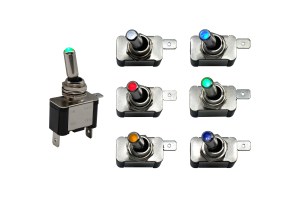
C&K’s ILT series toggle switches (Source: C&K)
One example comes from C&K. The company recently introduced its first illuminated toggle switch that offers space savings and withstands harsh environments. The ILT series is available in six LED color options and saves panel space by integrating the illumination mechanism within the switch instead of using a separate indicator light.
For harsh environments, the ILT series of toggle switches, rated to 20 A, features a metal bushing, making it suitable for harsh-environment applications such as control panels, heavy equipment, industrial instruments, instrumentation, LED lights, lifts and escalators, medical equipment, security systems, and telecommunication systems. Other features include 6.3 quick-connect terminals, an operating temperature range of –25°C to 85°C, and long-life operation up to 10,000 cycles.
C&K also expanded its illuminated keyswitch series with a smooth tactile feedback version. The new D6 Series features an integrated LED, which reduces costs and simplifies the design of the illumination path, said C&K.
Available in a wide range of colors, including bi-colors, the D6 series offers a mechanical life up to 100,000 cycles and an operating temperature of –20°C to 60°C. These keyswitches can be used in a variety of panel applications, including appliances, electronic games, industrial, medical, security and video, and test equipment.
For simpler customization and integration, the keyswitch is designed to enable easy X, Y coding on a single-side PCB. It also provides direct actuation without interface.
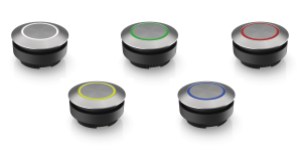
RAFI’s RAFIX 30 FS+ LED-illuminated pushbutton switches (Source: RAFI GmbH & Co. KG)
Another space-saving illuminated switch comes from RAFI GmbH & Co. KG. The company has upgraded its illuminated pushbutton family with a stainless-steel version. The RAFIX 30 FS+ LED-illuminated pushbutton is available with optional ring lighting for stylish indication. It offers distinct tactile feedback, even through gloves. Applications include automation, automotive, industrial, and off-road vehicle applications.
The RAFIX 30 FS+ pushbuttons are available with white, red, green, yellow, or blue lighting rings. The pushbuttons feature IP65 protection to the front side. They fit standard 30.3-mm installation openings and feature a button surface with a metal V2A insert. The button stands only 3.45 mm proud of the front panel.
For terminal connection, the pushbuttons can be used with PCB switching elements for PCB application or quick-connect switching elements for conventional wiring, providing flat housings. The PCB version has a mounting depth of 15.7 mm, and the switching elements with LEDs and other components are located on a common board. The quick-connect switching elements are connected individually with 2.8 × 0.8-mm quick connectors, resulting in a mounting depth of 33.3 mm. Illumination is via a plug-in LED clip.
Both types of switching elements are available in versions with gold contacts for a maximum of 35 V and 100 mA or with silver contacts for up to 250 V and 4 A.
Space saving is also big in anti-vandal switches, along with ruggedness. E-Switch’s new SV series of anti-vandal pushbuttons offers a compact body depth to fit limited space designs. The SV switches are available in three panel cutout sizes: 19 mm (SV4), 22 mm (SV7), and 25 mm (SV8). The body depth of the SV4, SV7, and SV8 is 19.2 mm compared with the PV series equivalent, which ranges from 34 mm to 41 mm in depth, depending on specific model.
All three models offer ring illumination or a ring/power symbol combo on a flat actuator, with both lens styles movable with the actuator. Multiple LED color options and illumination voltages are available.
The SV series, in an SPST contact arrangement, is IP67-rated for moisture and dust protection. It features a stainless-steel finish for the body and actuator and panel thicknesses from 1 mm to 6 mm. The mounting nut torque is 1 Nm to 3 Nm.
Other features include an electrical rating of 2 A, 36 VDC; 200,000-cycle electrical life; 1.80-mm travel; actuation force of 4.5 N; and dielectric strength of 2,000 VRMS at sea level. The operating/storage temperature ranges from –20°C to 70°C.
Applications include audio/visual equipment, elevator control pad, security devices, industrial controls, electrical housewares, public ticket dispensers, and vending kiosks.
DIP switches are alive and well and still being used in a range of telecommunications, industrial, and communications applications. CUI Devices said that this old technology is finding “new life” in IoT and smart-home devices with simplified pre-configuration.
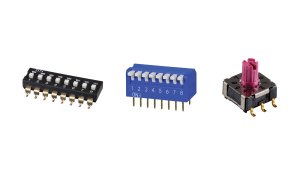
CUI’s DIP switches (Source: CUI Devices)
CUI Devices recently announced the first launch from its Switches Group with a new line of DIP switches, offering a variety of styles. Available in piano, rotary, and slide actuator types, the DIP switch family offers flat or raised actuator levels; convex- or flat-bottom options; short, long, or SMT pins; and gull-wing or PC-pin terminations.
Other key features include 1.27-, 2.54-, or 5.08-mm pitches; one to 16 positions; and surface-mount or through-hole mounting. Switching voltage is 24 or 42 VDC and non-switching is 42 or 50 VDC. Switching current is 25 or 100 mA and non-switching is 100 or 400 mA. The operating temperature range is –60°C to 125°C.
Several of the DIP switches offer IP67 ratings for applications with moisture and environmental contaminants. All models are certified to the UL94V-0 flammability rating and are RoHS-compliant. Applications include industrial, commercial, telecommunications, and IoT.
Electromechanical and solid-state relays
Relays come in two basic types: electromechanical and solid-state. They are basically switching devices except they are actuated by electricity. Electromechanical relays are actuated by electricity through a coil of wire that opens and closes the contacts and are specified by type, including general-purpose, power, reed, and contactors that are large relays designed to handle high current and voltage. There are also solid-state types based on silicon that inherently offer longer life because they don’t have mechanical parts that can wear out.
As electronic content grows in a range of applications, from appliances to automotive, there is a growing need to protect circuits from overload and faults. System designers are also looking to save board space.
Meeting the need to deliver higher functionality in smaller spaces, TE Connectivity has designed a 10-A power relay that meets high-inrush–capability needs in a space-saving design. The OJT power relays can withstand up to a 117-A inrush current (at ambient temperatures of up to 85°C) in a 40% smaller size compared with similarly rated relays, according to TE.
The miniature PCB relays measure 18.2 × 10.2 × 15.2H and are UL TV-8–rated to comply with global industry safety standards for high-inrush applications. This enables the OJT relays to be used in devices that have a high inrush current when the switch is turned on to help ensure safety and reliability.
The OJT relays are a 1 Form A, one normally open contact arrangement rated up to 10 A at 250 VAC. The devices are available in 5- to 24-V versions. Applications include indoor lighting, smart plugs, appliances (washing machines, refrigeration, and cooking), industrial machinery, motors, industrial controls, HVAC, printers, and power supply controls.
On the other end of the spectrum is a high-power 100-A relay from Omron Electronics Components with “exceptionally” low heat generation thanks to ultra-low contact resistance, said the company. Target applications for the Omron G7EB relay include distribution power conditioning systems (PCS) as well as test equipment such as semiconductor testers.
A challenge in high-current designs such as distribution PCS is controlling heat generation, said Omron. The new relay, which can switch up to 100 A at 800 VAC, offers an ultra-low 5-mΩ contact resistance, which significantly reduces heat generation in the component.
The low contact resistance improves reliability by reducing the heat stress on the device and the surrounding circuit, and it minimizes energy waste, said Omron. As a result, the G7EB exhibits a temperature rise to about 40°C with a 100-A carry current, compared with 80°C for competing designs, the company added.
The cooler operation also enables a reduced requirement for heat sinks, offering further space savings. In addition, the relay offers a compact design, measuring 40.5 × 50.5 × 37 mm, which also helps save space. The device is offered in both industry-standard and Omron proprietary pin layouts.
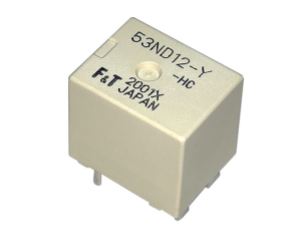
Fujitsu Components America’s FBR53-HC PCB relay (Source: Fujitsu Components America, Inc.)
Also saving space is the FBR53-HC PCB relay from Fujitsu Components America, Inc. The company recently expanded its automotive relay offering with this new 12-VDC PCB relay that features a switching capacity of 50 A at 14 VDC in the same size (12.1 × 15.5 × 13.7 mm) and weight (6 g) of a 40-A counterpart.
The PCB relay offers a maximum carrying current of 62.5 A, 14 VDC (30 minutes at 125°C) and an operating temperature of –40°C to 125°C, making it suitable for medium to heavy loads in automotive applications, such as electric power steering, radiator fans, fuel pumps, seat heaters, head lamps, and motor braking circuits.
The FBR53-HC is a mini ISO relay replacement that uses a 1 Form U dual contact arrangement normally open for high contact reliability. Other features include power consumption of approximately 600 mW and a typical electrical life of 100,000 operations. The RoHS-compliant relay is offered in a plastic-sealed package and in a through-hole reflow version.
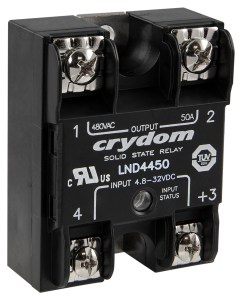
Sensata’s LN solid-state relay (Source: Sensata Technologies)
For longer life and higher reliability requirements as well as applications that need quieter operation, solid-state relays may be the right solution. Sensata Technologies offers a low-noise (LN) series of panel-mounted solid-state relays designed for consumer and industrial systems that require precise power control, long life, high reliability, and reduced levels of electromagnetic noise.
Thanks to no moving parts, instead using silicon-controlled rectifiers (SCRs), the solid-state relays provide quieter operation (no clicking), longer life, and more precision switching control, said Sensata. The LN relays offer reliable back-to-back SCR switching up to 75 A at 528 VAC.
In addition, the LN solid-state relays, from Sensata’s Crydom brand, feature a patented trigger circuit design in the relay that eliminates the need for filters, which reduces installation cost, according to Sensata.
Other features include zero-voltage turn-on switching, 3,500-VAC optical isolation, and built-in input/output overvoltage protection. An IP20 touch-safe housing and standoffs for PCB mounting are available.
The relays meet with IEC 60947-4-3 Environment B and CISPR 11 standards for low-voltage domestic, commercial, and light industrial locations/installations and are compliant with C-UL-US and TUV certifications. They are also EMC-compliant to Level III.
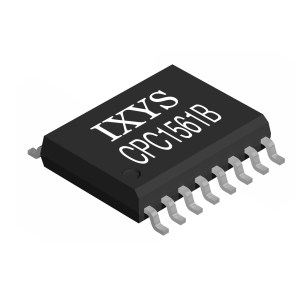
Littelfuse’s CPC1561B solid-state relay (Source: Littelfuse, Inc.)
For demanding applications, Littelfuse, Inc. recently launched a 1-A fault-protected solid-state relay with integrated current limiting and thermal shutdown. The company claims that the CPC1561B is the highest-current (1 A, 60 V) normally open solid-state relay currently available on the market to integrate both current-limiting and thermal-shutdown circuits.
Key features include active current limiting (circuitry senses load current and regulates MOSFET gate drives to survive overcurrent conditions), thermal-shutdown fault-mode protection at 128°C die temperature (works with active current control to protect the device), and auto-reset capabilities.
The surface-mount SSR’s dual-fault protection offers a rugged solution for demanding applications that is not possible with electromechanical relays and standard solid-state relays, said Littelfuse.
These include applications that cannot be down for long periods of time due to overcurrent, overtemperature, and electrical stress. Once the fault is removed, the solid-state relay resets and can resume normal conditions. Typical applications include smart homes, building automation, gaming, instrumentation, and battery-powered systems.
Advertisement
Learn more about Fujitsu Components AmericaOmron Electronic ComponentsTE Connectivity





